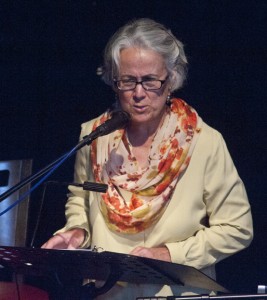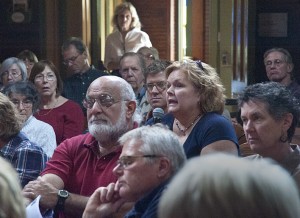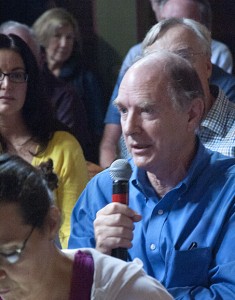Norfolk 2023! Event Draws Strong Community Support
By Wiley Wood

Historian Ann Havemeyer described difficult transitional periods in Norfolk’s history going back to the 19th century.
In fact, just over 150 residents of Norfolk attended, and their reasons appeared to cover a wide spectrum.
One undoubted draw was John Dankosky, the affable host of a morning talk show on Connecticut Public Radio. As moderator, the Winsted resident herded the panelists briskly over the issues, curbed the longwinded, put our first selectman glaringly on the spot—then gently helped her off it—and encouraged the shy to speak. Citing features of Norfolk that make it special, he particularly mentioned that its residents can’t agree on how to pronounce the town’s name.
But homogeneity has not been a feature of Norfolk, according to the historian Ann Havemeyer, since at least the mid-nineteenth century when manufacturing along the Blackberry River began to replace farming as the town’s main economic motor. The influx of Irish Catholic laborers—referred to by the minister on the hill as “semi-barbarous foreigners”—provided an early test of the town’s ability to accept diversity.
Another featured guest, familiar to Norfolk for his role in developing the 2009 town plan, was Glenn Chalder. His theme, repeated in different contexts during the morning, was that the mandate and money assigned by a town’s citizens to the municipal corporation will inevitably be limited, and that citizens, either alone or as part of civic action groups that coalesce around agreed-upon goals, must be the ones to bring about change.

Audience members made statements and asked the panelists questions. Above, Shirley Metcalf has the microphone.
Libby Borden, chairman of the Economic Development Commission and another panelist, evoked the vision of a coffeehouse, bookstore and meeting place in downtown Norfolk where residents could meet and mingle. But as the moderator and panelists struggled with the question of how a public good could be provided through private enterprise, the conversation quickly ran aground.
Lou Barbagallo, also a panelist, delivered the astounding fact that when he moved to Norfolk 40 years ago the town budget was $825,000. It is now $6.2 million and the population is approximately unchanged.
That Norfolk is an expensive town to live in was reiterated by many, who cited the costs of heating and transportation, the high taxes, and the relatively high cost of housing. Barbagallo stressed the need for affordable housing to draw and retain people of modest income. He was seconded by David Torrey, a local resident and landlord whose rental units currently house four families with eight children. Torrey encouraged the town to create a clearinghouse for financial advice, intended for people who might want to buy houses but who do not have the information on how to do it.
Kim Maxwell, who has been associated with a costly and innovative plan to bring high-speed fiber-optic communications to Norfolk, asked a simple question: “Should I continue or should I stop?” The burst of applause that greeted him was a clear indication that those present wanted him to continue. Dankosky responded from the stage with the suggestion that Norfolk might soon become “The Silicon Icebox.”
West Lowe had come to point out that 85 percent of Norfolk’s land is in forests or pastures and urged a concerted effort to put Norfolk’s physical assets to use for recreation. “There needs to be a way for that 85% to support the other 15%,” he said, and invited participants to imagine a linked trail system in Norfolk for walking, skiing and bicycling, possibly along the lines of the Rails to Trails program that has been so successful in Millerton. “This would bring people to town for the day, and they would bring their wallets,” said Lowe.
The meeting broke up shortly after the noon whistle. “Wow, does that thing go off every day?” asked the startled Dankosky.
As participants repaired to the Bistro for a complimentary light lunch, the buzz about the morning’s program continued to be heard around the salad bar. The town’s future may be in doubt, but the strong civic involvement of its residents is quite evidently not.
View the CATV 6 video of the event by clicking here: http://www.youtube.com/watch?v=ZSsTWy42XvY
PHOTOS BY BRUCE FRISCH


